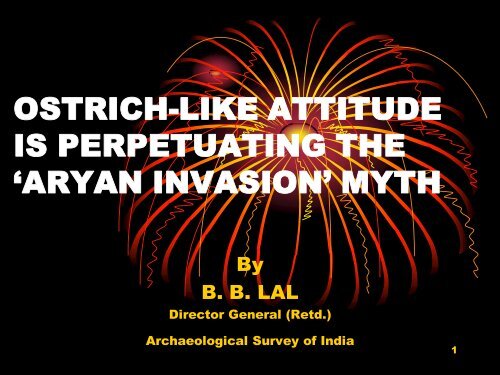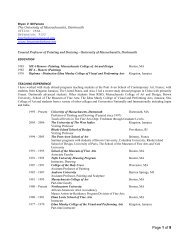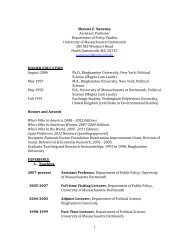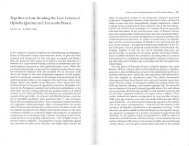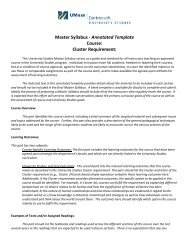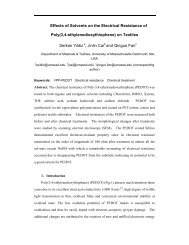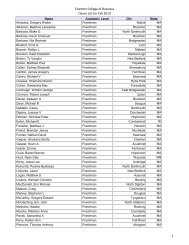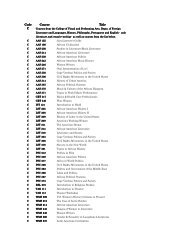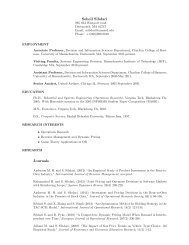'aryan invasion' myth
'aryan invasion' myth
'aryan invasion' myth
- No tags were found...
You also want an ePaper? Increase the reach of your titles
YUMPU automatically turns print PDFs into web optimized ePapers that Google loves.
OSTRICH-LIKE ATTITUDEIS PERPETUATING THE„ARYAN INVASION‟ MYTHByB. B. LALDirector General (Retd.)Archaeological Survey of India1
THE BACKGROUND OF THEMYTH• In 19 th Cent. Max Muller dated Vedas to1200 BCE on an ad hoc basis• Objections by scholars• Max Muller surrenders (Physical Religion,1890): “Whether the Vedic hymns werecomposed in 1000 or 1500 or 2000 or3000 BC, no power on earth will everdetermine.”• Pity, some scholars still cling to 1200 BCEand dare not cross this Lakshamana2Rekha
• In 1920s Harappan Civilization wasdiscovered and dated to 3 rd mill. BCE onthe basis of its contacts with West Asiancivilization• Since the Vedas had already been dated,be it wrongly, to 1200 BCE, the HarappanCivilization was declared to be Non-Vedic.And since the only other major languagegroupwas the Dravidian, it was readilyassumed that the Harappans were aDravidian-speaking people.• In 1946 Wheeler discovered a fort atHarappa; and since the Aryan god Indra ismentioned in the Rigveda as puramdara,i.e. „destroyer of forts‟, he declared thatAryan Invaders destroyed Harappan3Civilization (Ancient India, No.3, 1947).
FALLACY IN WHEELER‟SARGUMENT• In support of his „Invasion‟ theory, Wheelercited human skeletons at Mohenjo-daro(ibid.)• His interpretation is wrong; since theskeletons were found at differentstratigraphic levels and could not,therefore, be related to an invasion.• No evidence whatsoever of invasion at anyof the hundreds of Harappan sites. On theother hand, there is ample evidence ofcontinuity of habitation, though marked bygradual cultural devolution.4
Cont.• That no new people at all arrivedbetween 4500-800 BCE, is dulyestablished by a detailed study ofhuman skeletal remains by Hemphill(in Harappa Excavations, 1991).• Thus, if there is no evidence ofwarfare nor of an alien people andtheir material culture, where is thecase for any „invasion‟, much less byAryans?5
CLAIM THAT HARAPPANSWERE DRAVIDIAN-SPEAKERSIS WRONG• According to the „Aryan Invasion‟thesis, the Invading Aryans droveaway the Dravidian-speakingHarappans to South India.• If there was any truth in it, one wouldfind settlements of Harappan refugeesin South India, but there is not even asingle Harappan or even Harapparelatedsetllement in any of the6Dravidian-speaking States.
Contd.• Further, it is seen that even when new peopleoccupy a land, the names of at least some placesand rivers given by earlier people do continue. Forexample, in USA names of rivers like Missouri andMississippi or of places like Chicago andMassachusetts given by earlier inhabitants docontinue even after the European occupation.• But there is no Dravidian river/place-name in theentire area once occupied by the Harappans, viz.from the Indus to upper reaches of the Yamuna.• All told, therefore, there is no evidencewhatsoever for holding that Harappans were aDravidian-speaking people.7
A BACK-DOOR ENTRY• Having failed to establish „AryanInvasion‟, Romila Thapar (1988-91:259-60) invokes mechanism ofmigration of „pastoral cattlebreeders‟.• Toeing her line, R. S. Sharma (1999:77) says: „the pastoralist came fromBactria-Margiana ArchaeologicalComplex which saw the genesis ofthe culture of the Rigveda‟.8
Contd.• But can Sharma cite even a singlesite in India, east of the Indus – whichwas the main scene of the activity ofthe Rigvedic people – where remainsof BMAC have been found ?• He cannot, since there is none• Then why indulge in baselessspeculations ?9
ANOTHER BACK-DOOR ENTRY• Possehl (1996:65) holds: „the speakersof Vedic Sanskrit came fromelsewhere. This conclusion comesfrom .. Indo-European words for treessuch as birch, Scotch pine, linden,alder and oak. These are plants from atemperate environment and the factthat their names are shared amongthe early languages of the familysuggests a homeland in thisenvironment.‟10
.• The Rigveda does not mention any ofthe cold-climate trees referred to byPossehl.• On the contrary, all trees mentionedin the Rigveda, e.g. Asvattha (FicusReligiosa), Nyagrodha (Ficusbenghalensis), etc. belong to tropicalclimate.• The same is true for the fauna• Thus, a „cold-climate-home‟ thesis isabsolutely baseless11
WITZEL‟S ABORTIVEATTEMPT• In order to give a prop to the „AryanInvasion‟ theory, Witzel (1995: 320-21)deliberately mis-translates a part ofBaudhayana Srautasutra (18.44) asfollows: “ Ayu went eastwards. Hispeople are the Kuru-Panchala and Kasi-Videha. This is the Ayava (migration).(His other people) stayed at home inthe west. His people are the Gandhari,Parsu and Aratta. This is the Amavasugroup.”17
• The correct translation would,therefore, be: „Ayu migratedeastwards. His people are the Kuru-Panchalas and Kasi-Videhas.Amavasu migrated westwards (andnot stayed back, as Witzel says) .His people are Gandhari, Parsu andAratta.‟• In other words, the parting tookplace from an intermediary region,between Gandhara on the west andKurukshetra on the east. There is noquestion of any kind of migrationeastwards into India from the west.19
WERE THEN HARAPPANSTHEMSELVES VEDICARYANS?If there was no „Aryan Invasion‟ norwere the Harappans Dravidian-speakingpeople, could they themselves havebeen the Vedic Aryans ?Against such an equation fourobjections have been raised, namely:- (i) Whereas the Vedic people werenomads, the Harappans were urbanites;- (ii) The Vedic people knew the horse,while the Harappans did not;22
- (iii) Whereas the Vedic people usedspoked wheels, the Harappans did not;- (iv) Finally, since according to MaxMuller the Vedas were only as old as1200 BCE and Harappan Civilizationwas of the 3 rd mill. BCE, how can thetwo be equated, chronologically?• All these objections are baseless.Briefly:• Nomads ? Vedic people lived settledlife and constructed forts. In RV10.101.8 the prayer is: “Oh gods, makestrong forts as of metal.” RV 4.30.20mentions “hundred fortresses ofstone”.23
Contd.• Trade was carried on even on seas ….RV 9.33.6: “O Soma, pour thou forth fourseas filled with a thousand-fold riches.”The ships had sometimes as many as „ahundred oars (sataritra)‟.• Vedic people had sabhas and samitis andeven a hierarchy of rulers: Samrat, Rajanand Rajakas (RV 6.27.8 & 8.21.8). Thatthese gradations were real is confirmedby Satapatha Brahmana (V.1.1.12-13):“By offering Rajasuya he becomes Rajaand by Vajapeya, Samrat; the office ofRaja is lower and of Samrat, higher.”• Can we still call the Rigvedic people„Nomads‟ ?24
Contd.• The Horse. In his Mohenjo-daroReport, Mackay states: “The mostinteresting of model animals isone that I personally take torepresent the horse.”• Wheeler confirmed Mackay‟s view.• Now a lot of new material hascome to light: from Lothal,Surkotada, Kalibangan, etc.• Lothal has yielded a terracottafigure as well as faunal remains ofthe horse25
Contd.• Reporting on the faunal remainsfrom Surkotada, the renownedinternational authority on horsebones,Sandor Bokonyi ofHungary, emphasized: “Theoccurrence of true horse (EquusCaballus L.) was evidenced by theenamel pattern of the upper andlower cheek and teeth and by thesize and form of the incisors andphalanges (toe bones).”27
Contd.• Spoked wheel. Though the hotand humid climate of India doesnot let wooden specimenssurvive, there are enoughterracotta models of spokedwheels, e.g. from Kalibangan,Rakhigarhi, Banawali, etc.29
Chronological Horizonof the Vedas• It is most crucial to ascertain the exactchronological horizon of the Vedas,since the 1200-BCE fatwa of Max Mulleris at the root of the „Aryan Invasion‟theory• The mention of a shift of vernal equinoxfrom Mrigasiras to Rohini in the AitareyaBrahmana has led many astronomers toassign this text to ca. 3500 BCE andthus the Vedas to 4 th mill. BCE. I amincompetent to offer any comments, butwould suggest that an internationalseminar be held on this topic to thrash itout31
Contd.• However, of immense help is thecombined evidence ofarchaeology, geology, hydrologyand radiocarbon-dating• In this context, the role of RigvedicSarasvati is vital. According to RV10.75.5, it lay between Yamuna andSutlej; and flowed from mountainsto the sea (RV 7.95.2). It isidentifiable with the Ghaggar-Sarasvati combine which is nowdry downstream from Sirsa.32
• On Sarasvati‟s bank stands Kalibangan, animportant site of Harappan Civilization.• Hydrological investigations reveal that thesite had to be abandoned because of thedrying up of the Sarasvati – an event thattook place because of rise of Bata-Markanda Terrace in the Himalayas (Puriand Verma 1998).• It is interesting to note that thePanchavimsa Brahmana (XXV.10.16) toorefers to the drying up of the Sarasvati.• Radiocarbon dates show that Kalibanganwas abandoned around 2000 BCE.• Since the Sarasvati was a mighty flowingriver during the Rigvedic times and it driedup around 2000 BCE, the Rigveda has tobe dated to a period prior to 2000 BCE.36
Contd.• Since the Rigveda must be dated prior to2000 BCE and, according to RV 10.75.5-6,the Rigvedic people occupied the areafrom the Ganga in the east to the Indus onthe west, a question may straightaway beasked: „Archaeologically, which civilizationflourished in this very area prior to 2000BCE?‟ The inescapable answer will have tobe: “the Harappan”.• Hence a Vedic=Harappan equation. Thiswould be further reinforced by asatisfactory decipherment of the Harappanscript, which, however, still awaited.38
Contd.• Now, even if Vedic people and Harappans werethe same, were they indigenous ? The answer is“Yes”.• There is ample archaeological evidence todemonstrate that the Harappan Civilization,which attained maturity in 3 rd mill. BCE, had itsroots in 6 th mill. BCE. Some of the Carbon-14dates from recent excavations at Bhirrana in theSarasvati valley in modern Haryana are:• 4536, 5041 & 6439 BCE. In other words, theHarappans were the „sons of the soil‟.• Hence Vedic people too were “indigenous”.40
THE EVIDENCE OFGENETICS• A great deal of genetic research isbeing carried out which throws lighton this issue and I quote hereSanghamitra Sahoo et al. (2006: 843-48): “ The sharing of some Y-chromosomal haplogroups betweenIndian and Central Asian populationsis most parsimoniously explained bya deep, common ancestry betweenthe two regions, with diffusion ofsome Indian-specific lineagesnorthward. ….41
Contd.• … The Y-chromosomal dataconsistently suggest a largely SouthAsian origin for Indian castecommunities and therefore argueagainst any major influx, fromregions north and west of India, ofpeople associated either with thedevelopment of agriculture or thespread of the Indo-Aryan languagefamily.”42
OSTRICH-LIKE ATTITUDE• Seeing thou seeth not; knowingthou ignoreth. How long wouldstthou continue with this ostrichlikeattitude ?Shouldn‟t thou re-think and givethe „Aryan Invasion‟ theory aceremonial burial ?43
Overall Cultural Mosaic• As would be seen from the mapthat follows, the Vedic Aryansoccupied only the north-westernpart of the Indian subcontinent.• There were other culturalentities in other parts in 3 rd mill.BCE. All these got intermingledlater on in course of time andbrought into being thecomposite Civilization.44
REFERENCES• Hemphill, B. E., J. R. Lukacs and K. A. R. Kennedy. 1991. BiologicalAdaptations and Affinities of Bronze Age Harappans. In R. H. Meadow (ed.),Harappa Excavations 1986-1990, pp.137-82. Madison. Wisconsin:Prehistory Press.• Muller, F. Max. 1890, reprint 1979. Physical Religion. New Delhi: AsianEducational Services.• Possehl, Gregory L. 1996. Indus Age: The Writing System. New Delhi:Oxford & IBH Publishing Co. Pvt. Ltd.• Puri, V. M. K. and B. C. Verma. 1998. Glaciological and Geological Sourceof Vedic Sarasvati in the Himalayas, Itihas Darpan, Vol. IV, No. 2: 7-36.• Sahoo, Sanghamitra, et al. 2006. A prehistory of Indian Y chromosomes:Evaluating demic diffusion scenarios. PNAS, Jan. 24, vol.103,no.4,843-848.• Sharma, R. S. 1999. Advent of the Aryans in India. New Delhi: ManoharPublishers.• Thapar, Romila. 1988-91. In Journal Asiatic Society of Bombay, vol. 64-66,pp. 259-60.• Wheeler, R. E. M. 1947. Harappa 1946: The Defences and Cemetery R 37.Ancient India, 3;58-130.• Witzel, Michael. 1995. Rigvedic History: poets, chieftains and polities. InGeorge Erdosy (ed.). The Indo-Aryans of Ancient South Asia, pp. 307-52.Berlin: Walter de Gruyter.46


